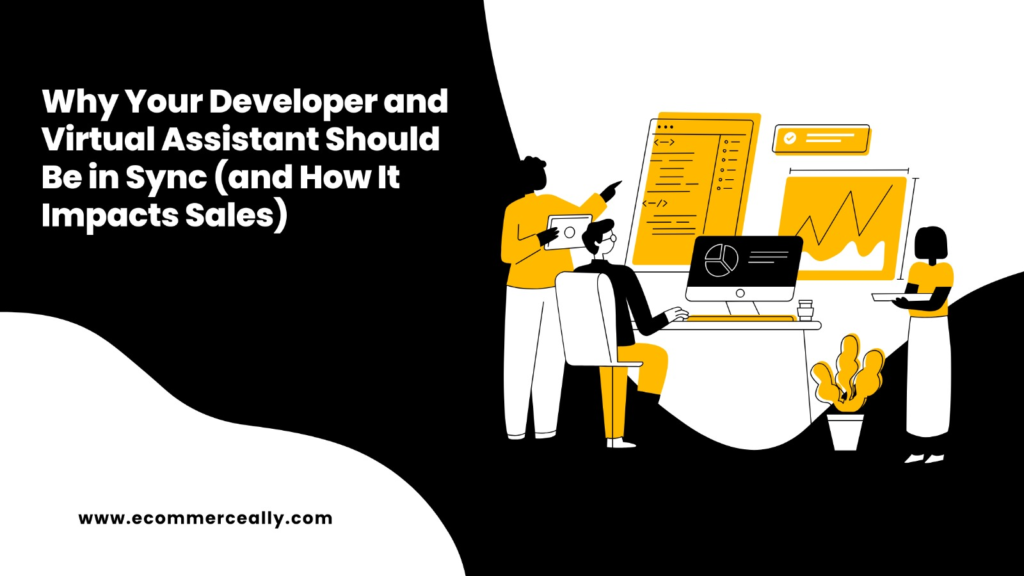In e-commerce, your online store is only as strong as the team running it. A brilliant developer might build a beautiful storefront, but without the right backend support, it can fall flat. Likewise, a sharp virtual assistant can manage listings and customer service like a pro—but if the technical side doesn’t cooperate, tasks pile up, bugs go unresolved, and sales suffer.
When your e-commerce developer and eCommerce virtual assistant are in sync, though, your store becomes a finely tuned machine—optimized for speed, efficiency, and conversion. Let’s explore why this coordination matters and how it directly impacts your bottom line.
The Two Pillars of Your E-commerce Engine
Your e-commerce developer handles the infrastructure: the design, functionality, and integrations that keep your website running smoothly. Think theme customizations, checkout flow, loading speed, and plugin management.
On the flip side, your eCommerce virtual assistant deals with the day-to-day grind—managing product listings, handling returns, responding to customer inquiries, uploading images, and tracking inventory.
Individually, both roles are essential. But together? They form a system that removes friction for your customers and drives repeat business.
Where Things Go Wrong When They Work in Silos
Let’s say your VA is uploading new products, but the developer recently changed the product page layout. Suddenly, images don’t align, descriptions look odd, and links break. The VA might not even know something’s off until a customer complains—or worse, bounces.
Alternatively, consider discount campaigns. Your VA sets up a promo, but the developer hasn’t updated the code to reflect the new pricing logic. Cart errors occur, sales stall, and support tickets increase.
Without communication, your e-commerce store becomes a game of broken telephone—and your revenue takes the hit.
When They Sync, Magic Happens
When your e-commerce development services team regularly communicates with your eCommerce virtual assistant, you unlock smoother workflows:
- Faster launches: Developers push updates, VAs check for front-end consistency, and adjust listings on the fly.
- Quicker troubleshooting: VAs flag issues customers report; developers fix bugs before they go viral on social media.
- Smarter automation: Developers set up backend systems; VAs test and maintain them daily.
- Better UX: VAs see the user journey in real time, offering feedback that developers can translate into design improvements.
This constant feedback loop helps you stay agile, especially during sales seasons, product drops, or unexpected surges in traffic.
Sales Go Up When Friction Goes Down
Coordination between your developer and virtual assistant translates into real dollars. Here’s how:
- Reduced cart abandonment: Errors in the checkout process are flagged and resolved quickly.
- Higher conversion rates: Clean product pages with the right layout, tags, and optimized images perform better—every click counts.
- Improved customer retention: When support is fast, the UI is clean, and everything works as expected, people come back.
Imagine a shopper landing on your site during Black Friday. If the site loads slowly, coupons don’t apply, or product info is confusing, they leave. But if the experience is seamless and polished, they buy—and possibly refer a friend.
Set the Rhythm: How to Get Them in Sync
Now that the benefits are clear, here’s how you can help your developer and eCommerce virtual assistant work together like clockwork:
- Weekly check-ins: Even a 15-minute alignment meeting can prevent countless hours of confusion later.
- Shared project tools: Use platforms like Asana, Trello, or Slack to keep everyone in the loop.
- Clear role boundaries with overlap: Developers don’t need to write product descriptions, but they should notify the VA if product templates change. Likewise, VAs should alert developers if they see recurring issues.
- Centralized documentation: Maintain a single source of truth for store processes, plugins, and workflows.
Conclusion
You don’t need a massive team to scale your store—you just need a smart one. Aligning your e-commerce development services with your eCommerce virtual assistant services bridges the gap between technical functionality and daily execution.
The result? Less friction, faster workflows, and an e-commerce experience that turns first-time shoppers into loyal customers.
At Ecommerce Ally, we help brands do exactly this—pairing the right VAs and developers so your store never misses a beat. Let’s build a system that works for you, not against you.
FAQs:
1. Why is a CRM important for a virtual assistant?
In the day-to-day running of a company, a customer relationship management system (CRM) aids a virtual assistant in managing client data, keeping tabs on interactions, planning follow-ups, and streamlining communication.
2. Do virtual assistants do sales?
Yes, virtual assistants can be a great asset to sales teams by helping with lead management, follow-up scheduling, customer relationship management (CRM) updates, outreach email creation and distribution, and order processing.
3. What are the three benefits of CRM?
Enhanced efficiency through automation of tasks and centralization of customer data for easier access and analysis, improved customer relationships, and increased sales through better targeting are the three advantages of customer relationship management (CRM).

